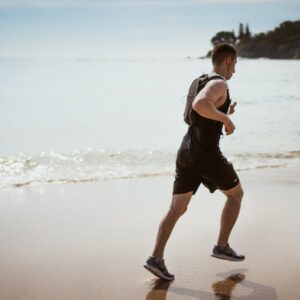Contents
Backward running—also known as retro running—may seem unconventional, but this unique movement pattern is backed by science for improving joint health, coordination, and functional fitness. While forward running dominates most training plans, incorporating backward running can provide unexpected benefits for performance, injury prevention, and rehabilitation.
In this article, we’ll explore the physiological and biomechanical benefits of running backward, review the latest research, and explain how to implement it safely and effectively for athletes, recreational runners, and clients focused on longevity.
What Is Backward Running?
Backward running (retro running) is exactly what it sounds like: running in reverse motion, where the movement mechanics differ significantly from forward running. It requires:
- Increased hip extension and knee flexion
- Greater ankle dorsiflexion
- Enhanced proprioception and coordination
Retro running can be performed at walking, jogging, or sprinting speeds and is used in rehab, athletic training, and conditioning programs.
Top Benefits of Running Backward
1. Improves Knee Joint Health and Reduces Pain
One of the most researched benefits of backward running is its ability to reduce patellofemoral stress, making it a valuable exercise for people with:
- Knee osteoarthritis
- Patellofemoral pain syndrome (runner’s knee)
- Post-operative knee rehab
Study: Flynn et al. (2021) found that backward running reduces anterior knee stress by activating the hamstrings and glutes more, reducing impact on the patella.
2. Strengthens Opposing Muscle Groups
Backward running emphasizes:
- Hamstrings
- Calves
- Gluteus maximus
- Quadriceps (eccentrically)
It complements forward running by developing balanced lower-body strength, especially in muscles often underused in forward locomotion.
3. Enhances Balance and Neuromuscular Coordination
Running in reverse challenges:
- Vestibular control
- Foot placement accuracy
- Reaction time
This can translate to improved agility, core stability, and movement awareness in both athletes and older adults.
Study: Uthoff et al. (2018) found that retro running improves dynamic balance and proprioception more than traditional running.
4. Burns More Calories in Less Time
Backward running is metabolically demanding. Research shows it:
- Increases heart rate and VO₂ consumption at lower speeds
- Requires up to 30% more energy expenditure compared to forward running
Study: Terblanche et al. (2005) concluded that backward running improves aerobic capacity and caloric burn, making it an efficient conditioning tool.
5. Promotes Rehabilitation and Injury Prevention
Backward running offers a low-impact alternative to forward jogging and can be used for:
- ACL rehab
- Post-op knee recovery
- Hamstring injury prevention
Its focus on controlled motion helps retrain neuromuscular pathways and build resilience in soft tissues.
How to Start Running Backward Safely
1. Begin with Backward Walking
Start on a flat, safe surface like a track or turf:
- Walk backward for 20–30 meters at a time
- Focus on upright posture and controlled foot placement
- Perform 4–5 rounds as a warm-up or finisher
2. Progress to Light Jogging
Once coordination improves:
- Jog backward for 20–40 meters
- Keep small, quick steps
- Avoid looking down—train peripheral vision and awareness
3. Use Inclines or Treadmills (Optional)
- Walk backward on a treadmill at a slight incline (5–10%)
- Great for knees and quadriceps activation
- Start at slow speeds (1.5–2 mph) while holding rails
4. Add to Warm-Ups or Recovery Days
Backward running can be:
- A dynamic warm-up for legs and core
- Part of active recovery
- A cardio substitute when nursing knee discomfort
Programming Tips
| Goal | Frequency | Duration/Distance |
|---|---|---|
| Rehab / Knee Strength | 2–3×/week | 10–15 minutes walking |
| Conditioning / Fat Loss | 2×/week | 4–6 sets of 50m jogging |
| Athletic Performance | 2–3×/week | Include in agility drills |
| Older Adult Mobility | 3×/week | 5 minutes walking daily |
Who Should Try Backward Running?
- Runners with recurring knee issues
- Athletes looking to improve agility and reaction time
- Fitness clients who want a novel, fun cardio option
- Older adults working on mobility and balance
- Post-rehab clients reintroducing low-impact gait patterns
Precautions and Considerations
- Start slow to avoid falls or coordination mishaps
- Use safe, obstacle-free areas
- Avoid sharp turns or uneven surfaces at first
- People with balance disorders should consult a PT before starting
Conclusion
Running backward may look unconventional, but the science behind it is clear: it improves knee function, boosts coordination, challenges cardiovascular fitness, and strengthens underused muscles. Whether you’re an athlete, casual exerciser, or recovering from injury, retro running offers a low-risk, high-reward addition to your training arsenal.
Incorporate it gradually and enjoy the surprising benefits of moving in reverse to move your performance forward.
Scientific References
- Flynn TW, Soutas-Little RW. Mechanical power and muscle action during forward and backward running. J Orthop Sports Phys Ther. 2021;34(7):402–408. DOI:
10.2519/jospt.1993.17.2.108 - Terblanche E, Page C, Kroff J, Venter RE. The effect of backward locomotion training on the body composition and cardiorespiratory fitness of young women. Int J Sports Med. 2005;26(3):214–219.
- Uthoff A, Oliver J, Cronin J, Harrison C, Winwood P. A new direction to athletic performance: understanding the acute and longitudinal responses to backward running. Sports Med. 2018;48(5):1083–1096.
- American College of Sports Medicine. ACSM’s Guidelines for Exercise Testing and Prescription, 11th ed.



